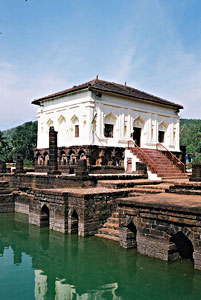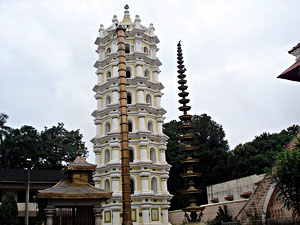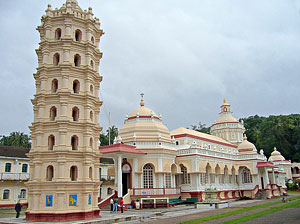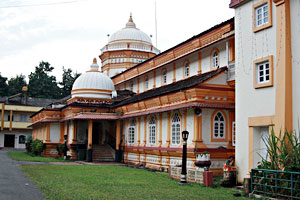|
|
Goa Pilgrimage
.....................................................................................................
|
|
The main pilgrimage places in Goa are the
mosques, temples and churches.
Mosques in Goa |
|
|
|
Safa Masjid
One of the only two sixteenth-century Islamic monuments
which managed to survive the excesses of the
Inquisition, the Safa Masjid lies 2 km west of the
centre of the town of Ponda, in Shahpur district. The
elegant structure was built in 1560 by Ibrahim Adil
Shah, the Sultan of Bijapur. The mosque was the focus of
attention in a fairly extensive complex of gardens and
fountains which lies in ruins today. The rectangular
prayer hall of the mosque rests above a high base and is
capped with a pointed terracotta tile roof. There are
elegant Islamic arches decorating the walls. Remnants of
octagonal pillars can be seen all around the mosque,
perhaps these supported a covered courtyard to provide
shade to worshippers. There is a well-constructed water
tank with small chambers with 'meharab' designs nearby
which is located to the south of the prayer hall unlike
most mosques where it is located outside the main
|
 |
|
|
entrance.
This has led to speculation that the tank may have been part
of another religious structure which once stood there. Local
legend also has it that there are hidden tunnels in the walls
of the tank which connect it to a nearby water reservoir. This
mosque is a venue of celebration during festivals of Id-Ul-Fitr
and Id-Ul-Zuha, by the local Muslim community. There are
rickshaws available at the main Ponda bus stand which can take
you to the site of the Safa Masjid.
Namazgah
A further 2 or 3 km. from the Safa Masjid, the road going
through the countryside, comes to suddenly upon the bare
mountainside where the mining activity is vast and somewhat
overwhelming.
This is one of the areas of great natural
wealth. Ore-barges, seen chugging down river on their way to
Vasco, are filled with ore from here. From the heights,
Bicholim is spread out below and in the distance are the
Shivalik mountains with the mines to the left, and behind. A
short distance to the right there is a small structure set on
the crest of the bleak hillside. This is Namazgah mosque, a
tiny remnant of Muslim history of Goa. This mosque was built
by Prince Akbar, to commemorate a battle which he and the
Marathas, led by Sambhaji, fought against the Portuguese in
1683. It was an unlikely alliance which came about after
Prince Akbar had rebelled against his father the Emperor. High
above Bicholim on this bare hillside with extensive views to
the east, the mosque is of most unusual design and interesting
layout. |
|
|
|
Temples in Goa |
|
|
|
Devaki Krishna Temple
The unique feature of the Devaki Krishna Temple is that
this is the only temple in India where Lord Krishna is
worshipped alongside mother Devaki as Devaki Krishna. The
main Deities Devakikrishna and affiliate deities of
Bhumika Devi, Laxmi Ravalnath, Mallinath, Katyayani,
Chodaneshwar and Dhada Shankar were originally located
at Choodamani island (Chorao island). To avoid
persecution during the Portuguese Inquisition they were
taken to Mayem in Bicholim and from there shifted to the
present location at Marcel. The Garbha Griha (inner
sanctum) of the temple has the beautiful idol of Devaki
and Lord Krishna. The idol of Devaki is in standing
posture with a child Krishna, between her legs. This
particular pose is considered to be unique. The idols
are beautifully carved in black |
 |
|
|
stone. The
major festival is Malni Purnima from Paush Vadya which is
celebrated over here with great fervour and excitement.
Mahalaxmi Temple, Bandivade
The village of Bandode or Bandivade is the location of a
number of temples among which is the large and beautiful
temple of Goddess Mahalaxmi. Bandode is approximately 22 kms
from the capital city of Panaji, off the main road to Ponda,
at Farmagudi. The temple has been in existence since at least
the year 1413, when information about the rituals of the
temple is found on stone plaques carved during the reign of
Nanjan Gosavi Pratihast over Goa. However, there was another
temple of Mahalaxmi in the fifteenth century in the town of
Colva in Salcette. As is the case with most Hindu deities in
Goa, the idol of Mahalaxmi from this temple was also smuggled
away in the middle of the night to avoid persecution during
the Portuguese Inquisition era of the sixteenth century. The
two devotees Safto and Fato, who took away the idol in a trunk
and first took her to the town of Talauli near Ponda. Till
today, the people of this village worship the sign of the feet
of the goddess. The idol brought from Colva was then taken to
Bandode and installed along with the existing idol. So today
there are two idols of Mahalaxmi in the temple premises, along
with other deities such as Shri Ravalnath, Shri Baleshwar,
Shri Narayan Purush and interestingly also idols of the two
devotees i.e. Safto and Fato who managed to save the Goddess
from Colva. The second Goddess Mahalaxmi from Colva is taken
out in a procession only once a year on the auspicious day of
Ramnavmi when she is taken around in a palakhi (palanquin) and
a chariot. On the second day of this festival, both the idols
are taken out in one chariot to be paraded in a huge
procession. The main idol of the Goddess Mahalaxmi is also
taken out during the festival of Mahashivratri, on a chariot
carried on the shoulders of devotees.
Mahalaxmi Temple, Panaji
One of the capital city's most discerning asset is the
Mahalaxmi Temple. Located on the Dada Vaidya road, the
Mahalaxmi deity is the chief object of veneration for all
Goans, irrespective of caste, class, sex or creed. This 182
year old temple has a fascinating history. On 10 July 1818,
the deity was consecrated there and the foundation stone of
the Mahalaxmi temple was laid. The pious devotees led by the
late Shri Narayan Kumar Mhamai, Mr. Sinari and others
consecrated the Mahalaxmi deity in the backyard of Panjim city
on 10 July 1818. By 1819, the temple was completed. The
original deity today lies in a small box in the rear wall of
the temple which faces the present main idol of Goddess
Mahalaxmi. The magnificent subhamandap of the temple has been
added later and today the recently completed new building of
the temple stands proudly as a superb addition to the
landmarks of Panjim city. |
|
|
|
Mahalsa
Temple
The temple of Mahalsa Narayani is located at the small
village of Mardol, 22 kms from Panaji, the capital city.
Originally, the deity was housed in a temple at an
ancient shrine in village of Verna which is now the site
of an industrial estate. Along with other Goan temples,
this temple was also destructed by the Portuguese around
1543. However, before the actual demolition could take
place the idol of the deity was smuggled away across the
river by faithful devotees, to Mardol, where it is
located today. |
 |
|
|
The Goddess
Mahalsa is supposed to be an incarnation of Lord Vishnu, hence
the name Mahalsa Narayani (Narayan being another name for
Vishnu). There are a number of legends associated with the
deity and how she came into being. In ancient times, a
beautiful goddess appeared on the Sonsada plateau at Verna.
She was first seen by a shepherd named Sahastrapal, who was
taking his master's cattle for grazing to a nearby spring. The
goddess asked the shepherd to bring his master to the
location. When the shepherd appeared reluctant saying that the
cattle were thirsty, the goddess created a spring by hitting
the ground with her nupur. The small Nupur Lake which was thus
created, can still be seen today. The shepherd went to get his
master, but could only get his son-in-law name Mhal Pai who
was asked by the goddess to build a temple in that location
where she would reside as Mahalsa Narayani. The temple has
huge wooden pillars and a silver framed doorway. In the
courtyard, there is a magnificent brass samai (ornamental lamp
pillar) which is 40 feet in height and has 21 rings of a
hundred fifty small lamps. When it is lit up with oil wicks on
the annual festival day or Jatra. Besides the Jatra, there are
two other special festivals held at the temple – the Jaiyanchi
Puja around the month of August and the Kojagiri Pornima just
after the monsoons on full moon day.
Anant Temple
The small village of Savoi-Verem in Ponda taluka is the site
of the only temple dedicated to Lord Anant in the state of Goa.
The temple is about 45 kms away from the capital city of
Panaji. This temple has only a tiled pyramid as roof and no
domes. The walls too, are only plain with plastering. But the
insides are in stark contrast to the outside. There is a
presence of all the seven colors of the rainbow in all the
intricate wooden carvings. The Ananta temple is dedicated to
Lord Vishnu, appearing here in his incarnation as Ananta, the
serpent. Although no definite date is available for its
original construction, the temple appears to be quite ancient.
The current building has pillars with intricate wooden
carvings and plated with silver. The idol of the deity is
carved in black stone and Lord Vishnu is shown here in his
Anantashayya (a sleeping position where the Lord rests on the
multi-headed snake king Seshnaga, whose heads shelter the head
of the Lord like an umbrella). This is the only temple in Goa
showing Lord Vishnu in this special posture. The sprawling
temple complex also consists of temples of other deities -
Shantadurga, Kamini, Narayan and Grampurush. A number of
festivals are celebrated at the temple including Shibikotsav
in which the palaki (palanquin) of Lord Ananta is carried by
devotees on their shoulders around the temple complex. |
|
|
|
Mangueshi Temple
The Mangueshi temple or the Manguesh Devasthan is
perhaps the most famous of all Goan temples. It is
located at Priol in Ponda taluka, about 21 kms from the
capital city of Panaji. The surrounding area is known as
Mangueshi. In ancient times the temple was located at
Kushasthali (present day Cortalim). During the
Portuguese Inquisition, a number of Hindu temples were
destroyed in Goa. To avoid a similar fate, the devotees
of God Manguesh removed the linga (symbol of Lord
|
 |
|
|
Shiva) from
the original temple and transferred it in the middle of the
night to the present location at Priol which was under the
control of Adil Shah. The shifting of the deity took place in
the year 1560. Since the time of of the shifting, the temple
has been rebuilt and renovated twice during the reign of the
Marathas and again in the year 1890. The final renovation
occurred in the year 1973 when a golden kalash (holy vessel)
was fitted atop the tall dome of the temple. There is a
fascinating legend attached to the name of the Lord Manguesh,
who is an incarnation of Lord Shiva. The ancient legend states
that Lord Shiva once lost everything he had in a game of dice
with his wife Parvati. He decided to go into self-imposed
exile and arrived in Goa. Parvati, unable to stay without Lord
Shiva for long, came looking for him in the jungles of Goa.
Lord Shiva decided to play a prank to frighten her and
disguised himself as a tiger which attacked her. Parvati cried
out for help in terror, 'Trahi Mam Girisha' (O Lord of
Mountains Save Me). Lord Shiva immediately turned himself back
into his normal form and the two were united. But the cry for
help, and the words 'mam girisha' became associated with Lord
Shiva. In the course of time the words abbreviated to
Manguirisha or Manguesh by which name he is known today. A
linga which was left to mark the place where the legend
occurred, was discovered by a local shepherd and eventually a
temple was built to house Lord Manguesh. The temple
architecture is a mix of Hindu, Christian and Muslim
influences and is lit up in magnificent lights during the
annual Jatra which is held in January.
Naguesh Temple
Around 25 kms from Panaji, in the village of Bandode, lies the
temple of Lord Naguesh. The area surrounding the temple is
known as Nagueshi and lies just 800 metres from Farmagudi on
the way to Ponda. There is a stone plaque near the temple,
dating back to 1413, which describes the donation of
surrounding lands to the temple by a local family. This was in
the reign of Veer Pratap Devraya of the Vijayanagar kingdom.
There are stone idols of Shiv-Paravati and Ganesh inside the
temple which actually date back to the seventh and eight
century which has led to the conjecture of the temple being in
existence since that time. Thus, unlike most temples in the
area, the Naguesh Temple has been in existence in its original
location for centuries. However, the present day building is a
recent construction having been renovated and patched up
around the year 1880.
The temple is dedicated to Lord Naguesh,
who was known as Nagnath in ancient times. Lord Naguesh is
another incarnation of Lord Shiva. Worth noting at the temple,
are the colourful images of gods and goddesses around the base
of the deepstambha (lamp tower). The temple has a magnificent
ancient tali (water reservoir) surrounded by palms. The
reservoir is built in such a way that standing at a certain
location around the tali, a person can view the reflection of
the idol of Lord Naguesh and the lighted lamps in the inner
sanctum. The deity is taken out in a palanquin and paraded in
huge chariots during the festival which is attended by
thousands of devotees. |
|
|
|
Ramnath Temple, Bandivade
The second temple in the small village of Bandode or
Bandivade as it is also known, is that of Lord Ramnath.
Located about 22 kms from the capital city of Panaji,
the temple is just a few minutes away from Farmagudi,
off the main road to Ponda. Legend has it that the name
of Lord Ramnath comes from the place Rameshwar. It is
said that Lord Rama, after slaying Ravana in the battle
was filled with remorse at the killing. In order to seek
redemption |
 |
|
|
for his act,
he installed a shivalinga (symbol of Lord Shiva), on the
shores and hence came to be known as Rameshwar or Ramnath. The
idol of Lord Ramnath was initially housed in a temple at
Loutolim which was set up by Gaud Saraswat Brahmins who had
migrated from Rameshwar on the southern shores of India. The
idol of the Lord Ramnath was removed from the original temple
at Loutolim and smuggled away to its present abode of
Bandivade, to avoid persecution by the Portuguese rule. The
temple also houses other deities like Shri LaxmiNarayan, Shri
Kamakshi, Shri Santeri and Shri Sidhanath. The sabhamandap
(grand hall) of the temple has no pillars and yet has a
special gallery for the ladies. There is a five-storied
deepstambha (lamp tower) in the courtyard with images of Hindu
saints carved on its base. The door to the inner sanctum has
some exceptionally beautiful scenes depicted on it in silver
metal. Once scene depicts devotees worshipping a linga, and
the other shows Lord Vishnu with his consort Lakshmi sitting
on his couch of a coiled snake. The annual festival or Jatra
of the temple is celebrated by the devotees with the
traditional palaki (palanquin) parading around the temple
carrying the idol of the deity.
Mallikarjun Temple
The ancient temple of Shri Mallikarjun is located near the
small village of Sristhal, in the southernmost taluka of
Canacona. Sristhal is about 5 km drive away from the taluka
headquarters of Chaudi which is about 75 kms from Panaji. The
temple lies in an enchanting location in a valley, completely
surrounded by blue mountains and greenery. The temple itself
is at least 200 years old. The temple is believed to have been
constructed during the Middle of the 16th century by ancestors
of the Kshatriya Samaj. It was renovated in the year 1778.
There are some extremely beautiful carved wooden pillars
inside the temple building. The carving has been done by
skilled craftsmen who were brought here from the south India.
The six pillars in the mandap (hall) have scenes from the
Puranas and Mahabharat carved on them. There are beautifully
carved profiles of dwarpal (doorkeeper) on either side of the
door leading to the inner sanctum. The temple is dedicated to
Shri Mallikarjun who is yet another incarnation of Lord Shiva
and he is also known as Adavat Sinhasanadhishwar Mahapati
Canacona among the locals. According to legend, the location
of the temple is supposed to be the place where Lord Shiva met
his consort Parvati after a long separation. The annual
festival or Jatra held at the temple is quite unique among the
temple festivals of Goa. Early morning on the day of the
festival, the idol of the deity is taken out in a procession
which travels for almost 2-3 hours to reach the nearby
Kindlebag beach. A number of rituals including a special bath
for the deity are held at the beach, after which the deity
returns to the temple. Hundreds of devotees have a holy bath
at the same time on the seashore. Besides the annual Jatra,
the temple is also famous for some unique occasions on which
some special rituals are held. |
|
|
|
Tambdi Surla Temple
The most ancient temple in the whole of Goa is located
at a place called Tambi Surla which is approximately 65
kms from the capital city of Panaji. The temple is built
in Jain style in the twelfth century. The size of the
temple is quite small and the top part of the temple has
never been completed. The small, beautifully carved and
perfectly proportioned black basalt temple is dedicated
to Lord Shiva. The temple has survived Muslim invasions
and Portuguese |
 |
|
|
persecution,
in its almost perfect condition mainly due to its remote
location in the forest at the foot of the Western Ghats. The
temple is located at the foot of the Anmod Ghat, which
connects Goa to the state of Karnataka. It is considered to be
the only specimen of Kadamba-Yadava architecture in basalt
stone preserved and available in Goa. The Kadamba dynasty
ruled Goa between the tenth and fourteenth centuries and built
the temple from the finest weather-resistant grey-black
basalt, carried across the mountains from the Deccan plateau
and lavishly carved in situ by accomplished craftsmen. The
intricate carvings created by these craftsmen adorn the
interior and the sides of the building. The temple faces east
so that the rays of the rising sun fall on the deity at the
crack of dawn. There is a small mandap (pillared hall) and the
inner sanctum is surmounted by a three-tired tower which is
incomplete or which has been dismantled sometime in the
distant past. Bas-relief figures of Lord Shiva, Lord Vishnu
and Lord Brahma, with their respective consorts appear on
panels at the sides of the temple. The mandap is covered with
a roof of plain grey sloping slabs. There is a headless Nandi
(bull, Shiva's vehicle) in the centre of the mandap,
surrounded by four matching columns. The symbol of the Kadamba
kingdom, an elephant trampling a horse is carved on the base
of one of the columns. There is a linga (symbol of Lord Shiva)
mounted on a pedestal inside the inner sanctum and local
legend has it that a huge King Cobra is in permanent residence
in the dimly lit interior. The festival of Mahashivratri is
celebrated at the temple.
Saptakoteshwar Temple
The Saptakoteshwar temple at Narve is considered to be one of
the six great sites of temples of Lord Shiva in the Konkan
area. The village of Narve is located about 35 kms from Panaji.
This is also an ancient temple, having the deity of the Kings
of the Kadamba dynasty around the twelfth century. The stone
plaque mentioning this order can still be seen near the temple
entrance today. The legend behind the name Saptakoteshwar is
also quite interesting. According to the legend, seven holy
sages once set out to pray to Lord Shiva near the place where
five holy rivers met the sea. They prayed for seven crore
years at the end of which, Lord Shiva appeared to grant their
wishes and agreed to stay at the place in one of his
incarnations. This incarnation is known as Saptakoteshwar (sapt
means seven and koteshwar means lord of crores). The most
important festival celebrated at the temple, is Gokulashtami
which is considered to be the day on which Lord Shiva appeared
in this incarnation to grant the wishes of the seven holy
sages. |
|